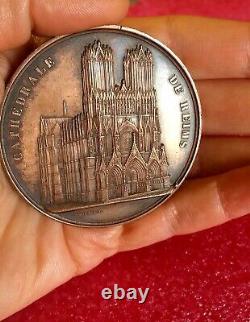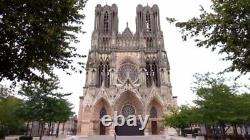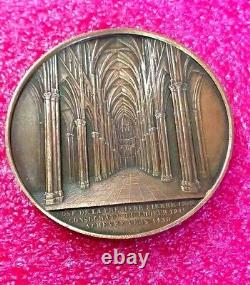1852 Jacques Wiener Cathédrale Notre-Dame de Reims medal French Royal Church






Meaning " Our Lady of Reims ". Known in English as Reims Cathedral , is a Roman Catholic. In the French city of the same name. The cathedral was dedicated to the Virgin Mary.
And is famous for being the traditional location for the coronation of the kings of France. The cathedral church is thought to have been founded by Bishop Saint Nicasius. In the early 5th century. Marking an important conversion, Clovis. Was baptized a Christian here about a century later. Construction of the present Reims Cathedral began in the 13th century and concluded in the 15th century. A prominent example of French Gothic architecture.It was built to replace an earlier church destroyed by fire in 1221. Although little damaged during the French Revolution. The present cathedral saw extensive restoration in the 19th century but was severely damaged during World War I. The church was again restored in the 20th century. Reims Cathedral is the seat of the Archdiocese of Reims.
The cathedral, a major tourist destination, receives about one million visitors annually. Founded the first church on the site of the current cathedral at the beginning of the 5th century.
On the site of a Gallo-Roman. The site is not far from the basilica built by Bishop Betause.
Where Saint Nicasius was martyred by beheading either by the Vandals. The dedication of the church to the Virgin Mary. Suggests that the latter of the two dates is the correct one, given that the first church to be named after the Virgin Mary. Was the Basilica di Santa Maria Maggiore.
The Reims church, measuring approximately 20 m (66 ft) by 55 m (180 ft). Was baptized by Saint Remigius. Some time between 496 and 508.
Was built in the 6th century to the north of the current site to a plan of a square exterior and a circular interior. The cathedral in the time of Archbishop Hincmar. In 816, the Frankish emperor Louis the Pious.
The coronation and ensuing celebrations highlighted the poor condition of the church, then the seat of an archbishop. Over the next decade, Archbishop. Of Reims rebuilt much of the church under the direction of the royal architect Rumaud.
Only ceasing in 846, under the episcopate of Archbishop Hincmar. Who adorned the church's interior with gilding. On 18 October 862, in the presence of King Charles the Bald. Hincmar dedicated the new church, which measured 86 m (282 ft) and had two transepts.
At the beginning of the 10th century, an ancient crypt underneath the original church was rediscovered. The crypt (which had been the initial centre of the previous churches above it) was cleared, renovated, and then rededicated to Saint Remi. The altar has been located above the crypt for 15 centuries. Beginning in 976, Archbishop Adalbero.
Began to enlarge and illuminate the Carolingian. A pupil of Adalbero, gives a very precise description of the work carried out by the Archbishop. He completely destroyed the arcades. Which, extending from the entrance to nearly a quarter of the basilica, up to the top, so that the whole church, embellished, acquired more extent and a more suitable form...
He decorated the main altar of the golden cross and enveloped it with a resplendent trellis. He lit up the same church with windows in which various stories were represented and endowed it with bells roaring like thunder. On 19 May 1051, King Henry I of France. Whilst conducting the Council of Reims.In 1131, Pope Innocent II. Anointed and crowned the future Louis VII. In the middle of the 12th century, Archbishop Samson. Demolished the façade and adjoining tower in order to build a new cathedral with two flanking towers, likely in imitation of the Abbey of Saint Denis. Whose choir dedication Samson himself had attended a few years earlier.
In addition to these works to the west of the building, a new choir and chapels began to be built east of the cathedral. Which measured 110 m (360 ft). At the end of the century, the nave and the transept were of the Carolingian style while the chevet. And façade were early Gothic. Cathedral was destroyed by fire on the feast day.
Of Saint John Before the Latin Gate, allegedly due to carelessness. Construction began when Archbishop Aubrey. Of the new cathedral's chevet. In July 1221, the chapel of this axially-radiating chevet entered use. Four architects would succeed each other until the completion of the cathedral's structural work in 1275: Jean d'Orbais. Jean-le-Loup, Gaucher of Reims and Bernard de Soissons. Documentary records show the acquisition of land to the west of the site in 1218, suggesting the new cathedral was substantially larger than its predecessors, the lengthening of the nave presumably being an adaptation to afford room for the crowds that attended the coronations. In 1233 a long-running dispute between the cathedral chapter. And the townsfolk (regarding issues of taxation and legal jurisdiction) boiled over into open revolt. Several clerics were killed or injured during the resulting violence and the entire cathedral chapter fled the city, leaving it under an interdict. (effectively banning all public worship and sacraments). Construction then continued more slowly. The area from the crossing. Eastwards was in use by 1241 but the nave. Work on the west façade took place in several phases, which is reflected in the very different styles of some of the sculptures.The upper parts of the façade were completed in the 14th century, but apparently following 13th-century designs, giving Reims an unusual unity of style. In 1429, by Jules Eugène Lenepveu. Unusually the names of the cathedral's original architects are known. A labyrinth built into floor.
At the time of construction or shortly after similar to examples at Chartres. Included the names of four master masons Jean d'Orbais. Jean-Le-Loup, Gaucher de Reims and Bernard de Soissons.
And the number of years they worked there, though art historians still disagree over who was responsible for which parts of the building. The labyrinth itself was destroyed in 1779 but its details and inscriptions are known from 18th-century drawings. The clear association here between a labyrinth and master masons adds weight to the argument that such patterns were an allusion to the emerging status of the architect through their association with the mythical artificer Daedalus. Who built the Labyrinth of King Minos. The cathedral also contains further evidence of the rising status of the architect in the tomb of Hugues Libergier. 1268, architect of the now-destroyed Reims church of St-Nicaise. Not only is he given the honour of an engraved slab; he is shown holding a miniature model of his church (an honour formerly reserved for noble donors) and wearing the academic garb befitting an intellectual. The towers, 81 meters (266 ft) tall, were originally designed to rise 120 meters (390 ft). The south tower holds just two great bells; one of them, named Charlotte by Charles, Cardinal of Lorraine.In 1570, weighs more than 10,000 kilograms (10 t). Following the death of the infant King John I. Was hurriedly crowned at Reims, 9 January 1317.
During the Hundred Years' War. The cathedral and city were under siege by the English from 1359 to 1360, but the siege failed.
In 1380, Reims cathedral was the location of Charles VI. S coronation and eight years later Charles called a council at Reims in 1388 to take personal rule from the control of his uncles.
After Henry V, King of England. Reims along with most of northern France fell to the English. The English held Reims and the Cathedral until 1429 when it was liberated by Joan of Arc.
Following the death of Francis I of France. Was crowned King of France on 25 July 1547 in Reims cathedral. On 24 July 1481, a new fire caused by the negligence of workers on the roof took hold in the attic, causing the destruction of the framework, central bell tower, and the galleries at the base of the roof, and caused the lead of the roof to melt, causing further damage. However, recovery was quick with Kings Charles VIII.
Making donations to the Cathedral's reconstruction. In particular, they granted the Cathedral an octroi. In regards to the unpopular Gabelle. In gratitude, the new roof was adorned by fleur-de-lis.And the royal coat of arms "affixed to the top of the façade". However, this work was suspended before the arrows were completed in 1516. Although Reims was an important symbol of the French monarchy, the chaos of the French Revolution.
Did not damage it to the same extent as at Chartres Cathedral. Where the structure of the cathedral itself was threatened. Some statues were broken, the gates were torn down, and the royal Hand of Justice.North portal of west facade. The original was damaged by shrapnel from German artillery shells.
Directed the restoration of Reims Cathedral. In 1875, the French National Assembly. On the outbreak of the First World War, the cathedral was commissioned as a hospital, and troops and arms were removed from its immediate vicinity. On 4 September 1914, the XII Saxon.Corps arrived at the city and later that day the Imperial German Army. The guns, located 7 kilometers (4.3 mi) away in Les Mesneux. Ceased firing when the XII Saxon Corps sent two officers and a city employee to ask them to stop shelling the city. The bombardment damaged the cathedral considerably, blowing out many windows, and damaging several statues and elements of the upper facade. On 12 September, the German Army.
Decided to place their wounded in the cathedral against the protests of Maurice Landrieux. And spread 15,000 bales of straw on the floor of the cathedral for this purpose. That day, however, the town was evacuated of German soldiers before French General Franchet d'Esperey. Six days later, a shell exploded in the bishop's palace, killing three and injuring 15. Scaffolding around the north tower caught fire, spreading the blaze to all parts of the timber frame superstructure.
The lead in the roofing melted and poured through the stone gargoyles. Destroying in turn the bishop's palace. Images of the cathedral in ruins were shown during the war by the indignant French, accusing the Germans of the deliberate destruction of buildings rich in national and cultural heritage. Restoration work began in 1919, under the direction of architect Henri Deneux, a native of Reims; the cathedral was fully reopened in 1938, thanks in part to financial support from the Rockefellers.
But work has been steadily going on since. Made a copy of "Le Couronnement de la Vierge" which can be seen above the cathedral entrance and with Louis Leygue. Copied many of the other sculptures on the cathedral facade. He also executed a statue of St Thomas for the north tower.
Was symbolically formalized in July 1962 by French president Charles de Gaulle. And German Chancellor Konrad Adenauer. Where in 1914 the Imperial German Army. Deliberately shelled the cathedral in order to shake French morale. The cathedral, former Abbey of Saint-Remi. And the Palace of Tau. Were added to the list of UNESCO World Heritage Sites. On his 74th Pastoral Visit.Visited Reims on 26 September 1996 for the 1500th anniversary of the baptism of Clovis. While there, the Pope prayed at the same chapel where Jean-Baptiste de La Salle. On 8 October 2016, a plaque bearing the names of the 31 kings crowned in Reims was placed in the Cathedral in the presence of Archbishop Thierry Jordan. And Prince Louis Alphonse, Duke of Anjou. One of many pretenders to the French throne.
Statues of Joan of Arc at Reims. Joan of Arc , by Prosper d'Épinay. Equestrian statue by Paul Duboi. The prestige of the Holy Ampulla.And the political power of the Archbishop of Reims. Resulted from King Henry I of France. Who was crowned here in 1027 and permanently established Reims Cathedral as the location of the coronation of the French monarch. All but seven of France's future kings would be crowned at Reims. The coronation of Charles VII.
In 1429 marked the reversal of the course of the Hundred Years' War. Due in large part to the actions of Joan of Arc. She is memorialized at Reims Cathedral with two statues: an equestrian statue.
Outside the church and another within the church. The item "1852 Jacques Wiener Cathédrale Notre-Dame de Reims medal French Royal Church" is in sale since Thursday, March 5, 2020. This item is in the category "Coins & Paper Money\Exonumia\Medals".
auction" and is located in Petach Tikva. This item can be shipped worldwide.

